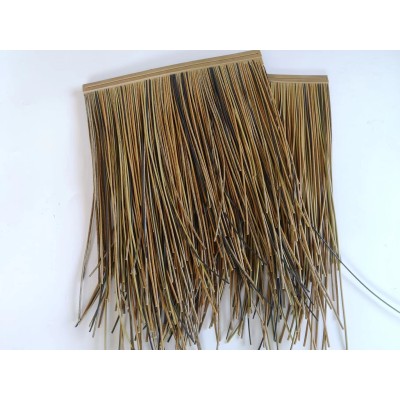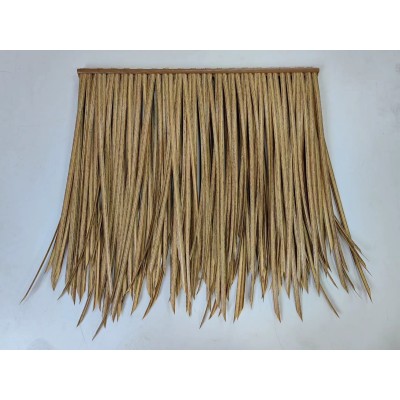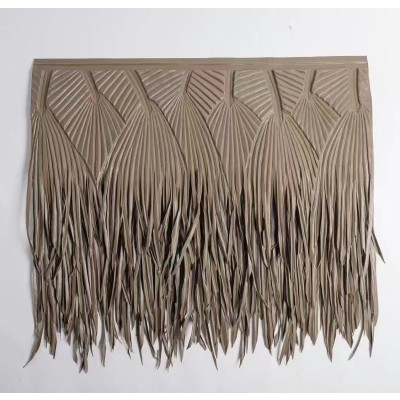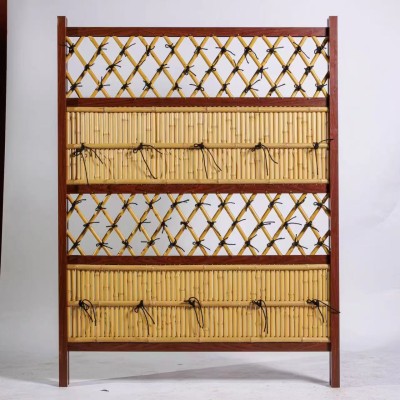Study on fire and UV protection materials of Cajan thatch roof in Maldives
Study on fire and UV protection materials of Cajan thatch roof in Maldives
Abstract: As a unique island country, Maldives has a unique Cajan thatched roof in its traditional architecture, but it is faced with problems of fire hazards and ultraviolet damage. This paper focuses on the research on the UV protection performance of Cajan thatch roof fire-resistant materials and synthetic thatch roof in Maldives. Through the exploration of material characteristics, preparation process, performance testing and other aspects, the paper aims to provide scientific basis for the optimization of building roof materials in Maldives and promote the sustainable development of local buildings. So that its traditional architectural style can continue under the modern security needs.
I. Introduction
Maldives attracts tourists from all over the world with its beautiful island scenery and unique culture, and the Cajan thatched roof in the local traditional architectural style is an important cultural symbol. However, because the thatch itself is flammable and easily degrades under long-term exposure to high-intensity ultraviolet light, it poses a threat to residents' life safety and building durability. With the development of science and technology, the development of fire-resistant and UV-resistant thatch roofing materials suitable for the Maldives environment has become a top priority, which is not only related to building safety, but also a strong support for the inheritance of local traditional culture.
Second, the impact of environmental characteristics of Maldives on thatch roof
Maldives is located in the tropics, strong sunlight throughout the year, high UV radiation dose, which makes the organic components in the thatch roof easy to undergo photooxidation reaction, resulting in fiber strength decline, color degeneration. At the same time, most of the local wooden building structures, once the thatched roof fire, the fire is easy to spread, threatening the safety of the entire living unit. The frequent sea breeze also accelerates the weathering process of the material, and the service life of ordinary thatch is greatly shortened in this harsh environment.
Third, Cajan thatch characteristics analysis
Cajan thatch has the advantages of light texture, good air permeability, beautiful shape and so on, which perfectly fits with the ventilation and heat dissipation pursued by Maldives architecture and close to nature style. However, its main components are flammable organic substances such as cellulose, with low limiting oxygen index and rapid combustion in case of open fire. When the fiber structure is exposed to ultraviolet radiation for a long time, the molecular chain is broken, and the macro performance is brittle and fragile, and the original mechanical properties are lost, which can not meet the needs of long-term use.
Four, fireproof material selection and modification
(1) Application of inorganic flame retardants
The selection of inorganic flame retardants such as aluminum hydroxide and magnesium hydroxide, which absorb a lot of heat by thermal decomposition, release water vapor to dilute the concentration of combustible gas, and form a thermal insulation layer on the surface of the thatch to prevent the spread of flame. The impregnation method was used to infiltrate the flame retardant solution into Cajan thatch fiber. The experiment showed that when the amount of flame retardant reached a certain proportion, the fire time of thatch was significantly delayed and the burning rate was greatly reduced.
(2) Coordination of organophosphorus flame retardants
The introduction of organophosphorus flame retardants combined with inorganic flame retardants, organophosphorus flame retardants can promote the formation of carbon layer in the burning process of thatch, and further enhance the heat insulation and oxygen insulation effect. After optimizing the mix ratio, the flame retardant performance of modified thatch meets the fire protection standard of building materials, and has little impact on its original appearance and texture, retaining the architectural characteristics of Maldives.
Study on ultraviolet protection of synthetic thatch roof
(A) ultraviolet shielding agent added
Nanometer titanium dioxide, zinc oxide and other ultraviolet shielding agents are uniformly dispersed in the base material of synthetic thatch. These nanoparticles can scatter and reflect ultraviolet rays and prevent them from penetrating the thatch material. It was found that the UV barrier rate of the material increased with the increase of the shielding agent content, but the flexibility and processing performance of the material were affected by the high amount of the shielding agent.
(2) Anti-ultraviolet coating
The surface of synthetic thatch is coated with fluoropolymer and acrylic anti-ultraviolet coating, which can absorb ultraviolet energy and form a physical protective barrier. By comparing different coating formulations, the coating system with strong weather resistance and good adhesion was selected. Outdoor aging test proved that the color retention and mechanical property maintenance time of the coated synthetic thatch were significantly prolonged under ultraviolet irradiation.
6. Comprehensive performance test and evaluation
The fire protection, UV protection, mechanical properties and weather resistance of modified Cajan and synthetic thatch roofs were tested. The results showed that the modified Cajan grass could effectively resist the invasion of open flame and meet the requirements of building fire safety in Maldives. The synthetic thatch treated with ultraviolet protection showed stable performance and long-lasting color in simulated tropical climate aging test. At the same time, the two structures are complete under the environmental stress such as normal wind and rain erosion, the mechanical properties are up to the standard, and the practical engineering application is feasible.
Vii. Conclusion and Prospect
JHYBAMBOO has successfully developed fire-resistant materials suitable for Cajan thatch roofing in Maldives and synthetic thatch roofing materials with excellent UV protection properties. Through scientific material selection and modification process, both the continuation of traditional architectural style and modern safety and durability requirements. Future research can further deepen the exploration of environmental protection of materials, reduce production costs, promote the large-scale promotion and application of these new materials in the field of construction in the Maldives, help the traditional buildings of the Maldives to radiate new vitality in the new era, and provide an example for the development of island building protection technology.



